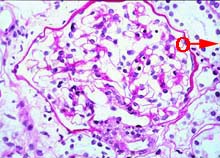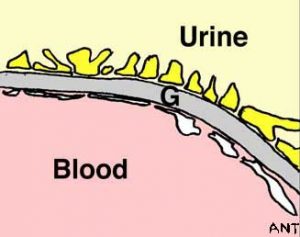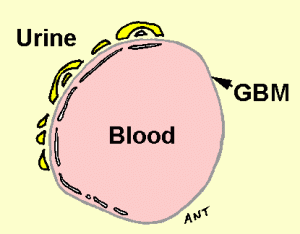On this page we describe the normal glomerular basement membrane (GBM) and then some of the diseases that involve it.
| Inherited diseases of the GBM include: | Other diseases of the GBM include: |
| Alport syndrome | Goodpasture’s (anti-GBM) disease |
| Thin GBM disease | Fibrillary nephritis |
| Benign familial haematuria | Other disorders |
| Nail patella syndrome |
The normal GBM
The GBM forms the boundary between blood and urine. Across it, water and other small molecules from the blood are filtered. This is described a little more in our page on normal kidneys. The GBM is made of a meshwork of proteins and other constituents. Type IV collagen and laminin are present in the largest quantities. Some specialized subtypes of these molecules are only found in specialised basement membranes such as the GBM. These are sometimes involved in kidney diseases.
Alport syndromeAlport syndrome is the second most common inherited cause of kidney failure. It is caused by a defect in one of the specialised types of type IV collagen. The GBM deteriorates with time, leading to progressive loss of glomeruli, often with deafness. Further information on Alport syndrome. Thin GBM diseaseIs exactly what it says. The GBM is thin, and must sometimes break, as it causes blood to appear in the urine. However it seems to repair without any ill effect, as thin GBM disease does not usually cause serious trouble. The condition often runs in families, and can be a cause of benign familial haematuria (see below).
The disease is diagnosed by a kidney biopsy in which the glomerulus is examined using an electron microscope to measure the thickness of the GBM. These measurements are not easy, and the normal thickness of the GBM varies a little with age. The approximate normal thickness is about one quarter of one thousandth of a millimetre. Some people with thin GBM disease carry an abnormal type IV collagen gene of the type that can cause Alport syndrome (see above). However they also have a normal copy of the same gene, which is usually enough to prevent serious trouble (cells contain two copies of all genes, except for those genes carried on the X chromosome. Where a disease only occurs if both copies are abnormal it is called ‘recessive’. Cystic fibrosis is the most common recessive disorder). Only when two people who both have abnormal genes have children together is there a risk that their children could have Alport syndrome (a maximum of a 1 in 4 chance for each child). This happens rarely and accounts for a small minority of cases of Alport syndrome. Some people with thin GBM develop more severe kidney trouble. Read more about this on the Alport syndrome page, in the section about Carriers. We don’t know why some people get more severe kidney disease. If you have Thin GBM Nephropathy (TBMN), it is wise to have an annual check of blood pressure, urine for protein, and probably a blood test of kidney function to be sure all is remaining well. There is a discussion of conditions causing blood to appear in the urine in our page on haematuria. Further information on thin GBM disease? We haven’t found any good sources. Benign familial haematuriaThe name just means that there is an inherited cause for blood appearing in the urine, and that those who have it don’t usually come to any harm. Thin GBM disease (see above) often appears to explain this condition, but there may be other possible explanations. If kidney biopsies have shown thin GBM disease in other family members, it will not usually be necessary to undertake it in everyone who has blood in the urine. There is a discussion of conditions causing blood to appear in the urine in our page on haematuria. Nail-patella syndromeThis rare inherited condition has a surprising and unusual mix of different features. People who inherit it may have hardly anything to see, or they may have all of these. The most common features are:
Inheritance of the disease is ‘autosomal dominant’, which means that on average, one in two of the children of someone with Nail Patella Syndrome will inherit the condition. However people vary very much in how severely they are affected – from badly, to hardly at all. Kidney disease does not always occur, and when it does it may be minor. Unfortunately in some people it is more serious and it may cause a protein leak (nephrotic syndrome), and in time progress to kidney failure. No way to prevent this from happening is known. Treatment is the same as for nephrotic syndrome and kidney failure of other types. The gene causing Nail Patella Syndrome has been identified and is called LMX1B. This gene seems to control the amount of collagen produced in GBM, although how it causes the other features of the disease is not known. Further information is available from:
Goodpasture’s diseaseGoodpasture’s disease is an ‘autoimmune’ condition in which there can be severe inflammation affecting the kidneys and or lungs. More information is available: Fibrillary nephritisThis is a very rare condition in which the GBM is thickened by abnormal fibres that can be seen using an electron microscope. This disease has been discovered relatively recently and unfortunately remains poorly understood. It often causes a protein leak and nephrotic syndrome. Deterioration to kidney failure is common. Other diseases affecting the GBMThe GBM is thickened with normal basement membrane material in two common kidney disease, membranous nephropathy and diabetic nephropathy (kidney disease caused by diabetes). Follow the links for further information.
Acknowledgements: The author of this page was Neil Turner. It was first published in 2001. The date it was last modified is shown in the footer. |




